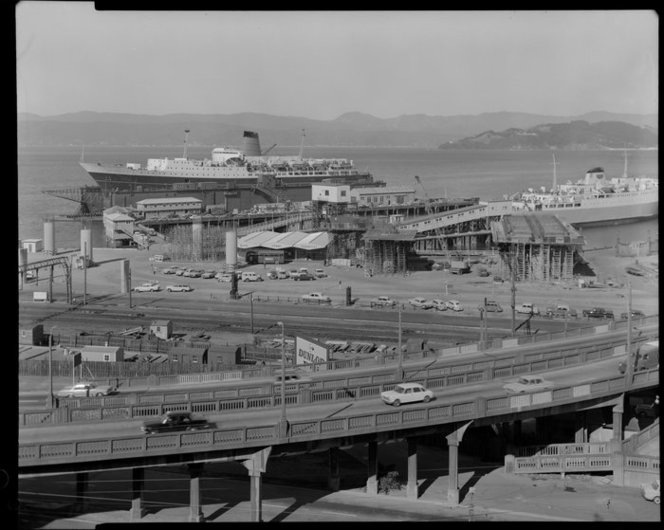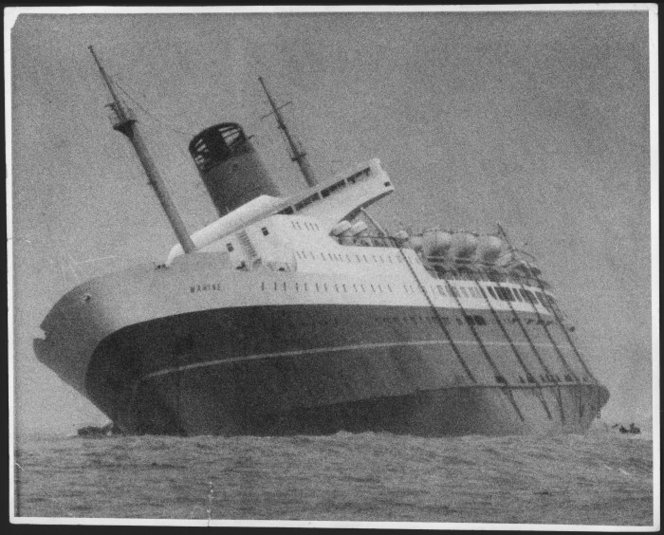This week’s selected topic comes from the Today in History page at nzhistory.net.nz. The New Zealand Collection is located on the second floor of The Central Library. Each week we feature topics in the This Week in History display in the NZ Collection and using available databases and the library collections to illustrate and provide additional information. This week we remember the sinking of the Wahine in Wellington Harbour.
10th April 1968 The Sinking of the Wahine
The Wahine was one of the two ships that maintained a regular service between Wellington and Lyttelton. Each ferry was drive-on and provided sleeping accommodation for the passengers.

Hutt Road Thorndon Quay offramp, railway lines and ferry terminals with the Wahine and one other ferry at the wharf. Winder, Duncan, 1919-1970 :Architectural photographs. Ref: DW-5389-F. Alexander Turnbull Library, Wellington, New Zealand. http://natlib.govt.nz/records/22775328
On the evening of the 9th April the Wahine set out from Lyttleton on the regular overnight service. There were 123 officers and 610 passengers onboard and a stowaway who was travelling to Wellington to join the crew of the rail ferry Aramoana in Wellington which was not an uncommon unofficial way to travel. The ferry was en route from Lyttelton to Wellington when it fell victim to one of the most ferocious storms in New Zealand’s recorded history. With the loss of 52 lives (a 53rd victim died in 1990 from injuries sustained in the wreck), this was our worst maritime disaster since the loss of the Penguin in 1909.

Wahine sinking in Wellington Harbour. Further negatives of the Evening Post newspaper. Ref: EP/1968/1647/14-F. Alexander Turnbull Library, Wellington, New Zealand. http://natlib.govt.nz/records/22327912
The wreck of the Wahine lay near the harbour entrance for 5 years with the last pieces of the ship being removed in 1973. The salvage work sadly also claimed the life of one of the divers involved in the dangerous underwater cutting work.

Hikitia floating crane lifting a portion of the ferry Wahine, Wellington. Negatives of the Evening Post newspaper. Ref: 35mm-00036-b-F. Alexander Turnbull Library, Wellington, New Zealand. http://natlib.govt.nz/records/22467631
The wrecking of the Wahine is often studied and we have some very useful resources here in the New Zealand Collection and library databases. Although online New Zealand newspaper databases do not cover the year of the Wahine sinking, the New Zealand Collection has a Local History Collection that is a collection of newspaper and magazine clippings. The clippings are organised in a searchable database called the Wellington Local History Vertical Files and by asking at the 2nd floor desk using the file names you find you will be rewarded with envelopes full of newspaper clippings. We also have the Evening Post Clippings Collection, 1927 – 1977 and a search of this database will provide a large collection of clippings both about the disaster and the inquiry that followed.
There is an overseas newspaper database that does cover this timeframe and by searching the Times Digital Archive from the mygateway.info library databases I was able to read the report on the Wahine disaster on the front page of The Times newspaper and see pictures on page 12 from the 11th April 1968. Once you have logged into the database with your library card, you can read this here
Our library webpages also have a page about the Wahine disaster which includes a list of the resources available from our library catalogue. One of the resources is an educational kit from Newspapers in Education that has a number of A2 pages featuring some of the newspapers stories from the time of the shipwreck.
A very moving documentary about the Wahine disaster screens at the Museum of Wellington City and Sea every 30 mins and there is a collection of YouTube video showing film footage from the Wahine disaster which can be viewed here.
The Emmanuel Makarios book The Wahine Disaster featured below has been a useful resource for this blog post.
 The Wahine disaster : a tragedy remembered / Emmanuel Makarios.
The Wahine disaster : a tragedy remembered / Emmanuel Makarios.
“A study of one of the worst maritime disasters in New Zealand history. Drawing on oral history and archival records it provides a vivid account of the events of 10 April 1968”–Inside cover.
The M word : everything you need to know about the menopause / Kaye, Philippa







